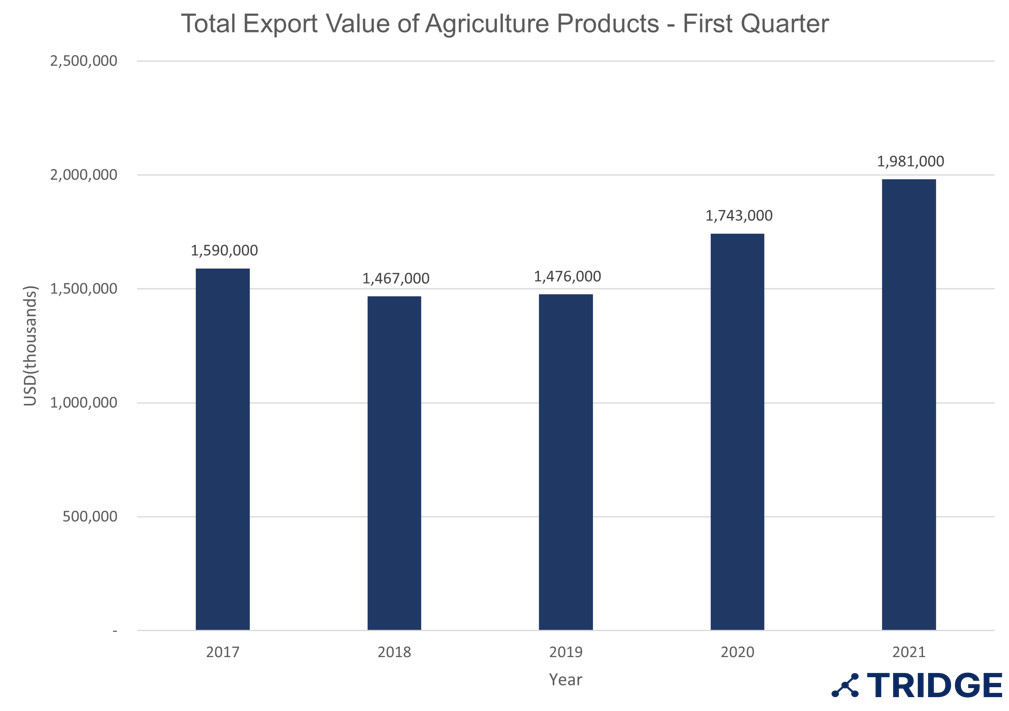Shine Muscat Craze Continues amid Pandemic
Although most countries are facing an economic recession with the unprecedented pandemic, the export value of the Shine Muscats in South Korea reached its record-high point with USD 1.9 billion in Q1 2021, an increase of 13.7% from the same period in the previous year. According to the Ministry of Agriculture, Animal Industry and Fisheries in Korea (MAFRA), the increased export value is primarily attributed to the high demand for Shine Muscat grapes in South East Asian markets, such as Hong Kong, Singapore, and Vietnam. Despite the high price due to a decrease in production volume in Korea, the demand has increased in main exporting markets throughout 2020.
Recently, the Agricultural Research & Extension services of Gyeongsangbuk-Do developed advanced technology for the storage systems. Before then, the harvested shine muscat could only be stored for 2-3 months. Since the harvest season for Shine Muscats is in October, the grapes could be sold in the domestic market and exported until February at most. However, with new storage technology that minimizes defects and maintains moisture, Shine Muscat grapes will be available in the global market even in the spring season. According to the Governor of Gyeongsangbuk-do, Munsu Lee, the global export value is projected to double up annually thanks to the new technology. He further added that the market price will be stabilized shortly as the supply will now be available for the whole year.

Premium quality wins
Shine Muscats, which are a seedless,edible-peel grape variety with mango flavor, is originally from Japan, with it only being five years since Korea started to export the variety. However, with the government’s support, Korea began to offer lower prices for the grapes, with better quality than the Japanese ones, turning Shine Muscat from Korea to lead the Asian grape market from 2016. Despite its higher price compared to the Campbell and Kyoho varieties, Korean Shine Muscat attracts the luxury fruit market in Asian countries with its premium quality. Recently, the overall production and export volume increased significantly, thanks to the low-temperature supply system and strict quality control management. These improvements in quality have made the product popular in the global market, particularly in China and Vietnam. With the rise of the Shine Muscat market, the export value of Korean grapes has increased by ten times from 2012 to 2020. The export value in Q1 2021 reached USD 7 million, an increase of 49.7% compared to the same period last year.
Trend of top 10 Grape importers from Korea, 2013-2020

International competitiveness of Korean agriculture
The agriculture sector in Korea is often believed to be less competitive due to the presence of cheap imported products and the instability of the industry. Since the agriculture industry opened the door towards the global market a decade ago, consumers started to choose cheaper imported fruits and veggies than domestically produced ones. On top of that, compared to the main agri-producing countries such as the US and China, the agricultural territory is much smaller in Korea, and the labor force is not sufficient to fulfill the domestic demand. Only less than 4% of the total population works for the agriculture sector, and the proportion of people less than 40 years old represents 30% of the total labor force in the agriculture sector. As the whole country entered an aging society, the agriculture sector in Korea has become even more vulnerable and unpredictable.
In this case, premium and specialty commodities can be a key factor in reviving the agriculture sector. Since imported goods are much cheaper than domestically produced products, it is hard to compete directly with conventional products in the global market. However, as can be seen from the success story of Shine Muscat from Korea, premium and specialty products created large demand from the global market despite its higher price than other grape varieties. With the advancement of storage technology, premium-quality Shine Muscats will be available throughout the whole year, which is expected to bring more revenue to Korea.
Sources:
- Munhwailbo, "Shine Muscat in Gyeongsangbuk-do, triple its exports in three years."
- KATI, "Analysis of Shine Muscat Grape Exports to China"
- Kukminilbo, "The reason why Shine Muscat swept in China?"
- KREI, "Agricultural Outlook 2019: Values and Opportunities of Agriculture and Rural Areas and the Future"
- Yonhap, "Shine Muscat Long-Term Storage Technology allows Exports in Spring"





